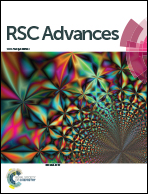Poly(γ-glutamic acid)-stabilized iron oxide nanoparticles: synthesis, characterization and applications for MR imaging of tumors†
Abstract
We report a facile poly(γ-glutamic acid) (PGA)-assisted “one-step” synthesis of Fe3O4 nanoparticles (NPs) for in vivo magnetic resonance (MR) imaging of tumors. In this work, a mild reduction method was employed to synthesize Fe3O4 NPs in the presence of PGA. We show that the formed PGA-stabilized Fe3O4 NPs (Fe3O4-PGA NPs) display good water-dispersibility, colloidal stability, relatively high r2 relaxivity (333.7 mM−1 s−1), and good cytocompatibility and hemocompatibility in the studied concentration range. Cellular uptake results demonstrate that the Fe3O4-PGA NPs have minimum macrophage cellular uptake, which is beneficial for them to escape the uptake by the reticuloendothelial system in vivo. Importantly, the formed Fe3O4-PGA NPs can be used as a contrast agent for MR imaging of tumors in vivo thanks to the passive enhanced permeability and retention effect. The developed Fe3O4-PGA NPs may hold great promise to be used as a contrast agent for MR imaging of different biological systems.


 Please wait while we load your content...
Please wait while we load your content...